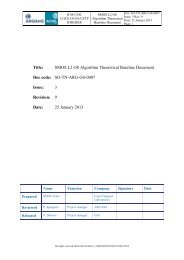Kent, C., Jackson, J., Borg, A., Sautreau, D - ARGANS
Kent, C., Jackson, J., Borg, A., Sautreau, D - ARGANS
Kent, C., Jackson, J., Borg, A., Sautreau, D - ARGANS
Create successful ePaper yourself
Turn your PDF publications into a flip-book with our unique Google optimized e-Paper software.
Figure 3: ESA Landsat 5 European coverage available<br />
in the EOLI-SA catalogue.<br />
The Landsat SPPA Team provide support to the large<br />
Landsat community by updating FAQs and<br />
documentation, which are made available on the ESA<br />
Landsat webpage [14], offering Users a source of<br />
information for better comprehension of, and utilization<br />
of, the Landsat data. In addition to this, the SPPA Team<br />
provide Users with expert advice to requests and<br />
questions via the EO Help Desk.<br />
In order to monitor data quality, and observe and report<br />
on changes occurring in the sensor over its lifetime,<br />
LLSA activities are carried out by the Landsat SPPA<br />
Team. Analysis of the ageing of the sensor is carried out<br />
over two Vicarious Calibration test sites: Libya-4 (Path<br />
181, Row 40) and Lacrau, France (Path 196, Row 30)<br />
[15].<br />
Since June 2009 a new radiometric correction based on<br />
in-flight calibration has been applied to Landsat data,<br />
this is known as the LifeTime Model (LTM). This new<br />
model offers better precision for radiometry when<br />
compared to the previous calibration which was based<br />
on pre-flight calibrations<br />
5. GMES AND QA4EO<br />
Within the GMES programme [16], ESA is responsible<br />
for developing a harmonised system that facilitates<br />
access to EO data; this is achieved through the GMES<br />
Space Component Data Access (GSCDA) system. This<br />
includes the development and operational service of the<br />
Coordinated Quality Control (CQC) which ensures full<br />
traceability and accessibility of the Quality Information<br />
Items (e.g. documents, reports, auxiliary information).<br />
The CQC is also tasked to coordinate anomaly<br />
investigations, detailed quality control and quality<br />
assurance analysis for GMES Contributing Missions<br />
(GCMs); this is currently being achieved through<br />
coordination with the relevant instrument SPPA Teams.<br />
QA4EO [17] has been established by the Committee on<br />
Earth Observation Satellites (CEOS) to facilitate the<br />
Group on Earth Observations (GEO) vision for a Global<br />
Earth Observation System of Systems (GEOSS). The<br />
aim is to provide a global infrastructure that generates<br />
comprehensive near-real-time environmental data,<br />
information and analysis for a wide range of users.<br />
QA4EO is based on the adoption of guiding principles,<br />
which are implemented via guidelines derived from best<br />
practices. Evolution activities are currently ongoing to<br />
ensure all GCMs are QA4EO compliant.<br />
6. CONCLUSION<br />
Space-borne optical sensors provide invaluable data<br />
regarding the changes and alteration in the atmospheric,<br />
oceanic and terrestrial environments to the global<br />
scientific community; resulting in a consistent<br />
requirement to ensure the generated products are of<br />
sufficient quality throughout the lifetime of the mission.<br />
The activities of the MERIS, MODIS, SeaWiFS and<br />
Landsat SPPA Teams at <strong>ARGANS</strong> benefit from the<br />
expert support of ACRI-ST and Gael Consultant, and as<br />
a result, provide support to ESA in a variety of QC<br />
activities including automated analysis and checking of<br />
products, LLSA, software and hardware update<br />
validations, general monitoring of product catalogues,<br />
and support to User forums and FAQs.<br />
These activities form part of an ever-evolving service<br />
which aims to harmonize an approach to operational<br />
quality control across all EO instruments. The GMES<br />
and QA4EO initiatives have been discussed, and it’s<br />
understood that these are important steps towards crossplatform<br />
harmonization, and will represent a new<br />
milestone in the consistent delivery of a high quality<br />
product to the wider scientific community.<br />
7. References<br />
1. ESA (2010). The ESA Earthnet MERIS webpage,<br />
http://envisat.esa.int/instruments/meris/<br />
2. ACRI-ST (2010). The MERIS Daily Report,<br />
http://www.dpqc.org/meris_dpqc/<br />
3. Brockmann Consult (2010). The BEAM VISAT<br />
Tool, http://www.brockmann-consult.de/cms/web/beam/.<br />
4. ESA (2010). The ODESA Webpage,<br />
http://earth.eo.esa.int/odesa/<br />
5. ESA (2010). Implementation of Envisat extension<br />
Orbit Scenario in October 2010,<br />
http://earth.esa.int/object/index.cfm?fobjectid=6999<br />
6. ESA (2010). Third Party Missions,<br />
http://earth.esa.int/thirdpartymissions/



